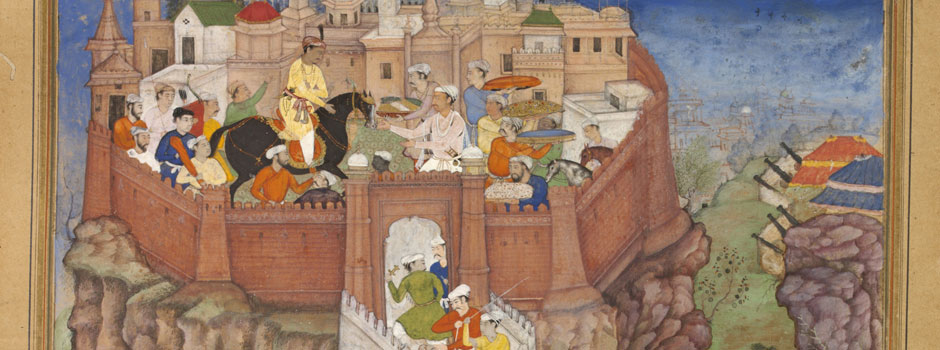
An Exhibition at the Fondazione Roma Akbar. The Great Emperor of India
Oct 18, 2012 Exhibition
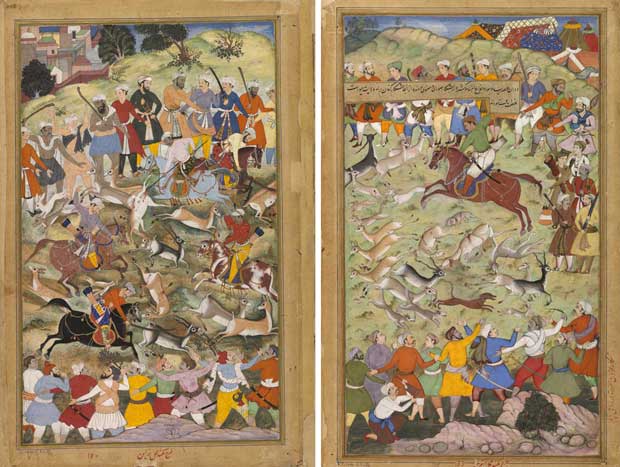 Left: Composition by Mukund, painting by Manohar, Akbar hunting near Palam near Delhi, Folio from the Akbarnama (Book of Akbar), c. 1590-95, Ink, opaque watercolor and gold on paper, 37,6 x 24,3 cm / Victoria and Albert Museum, London // Right: Composition by Mukund, painting by Narain – Akbar hunting near Palam near Delhi, Folio from the Akbarnama (Book of Akbar), c. 1590-95, Ink, opaque watercolor and gold on paper, 37,8 x 25,9 cm /Victoria and Albert Museum, London
Left: Composition by Mukund, painting by Manohar, Akbar hunting near Palam near Delhi, Folio from the Akbarnama (Book of Akbar), c. 1590-95, Ink, opaque watercolor and gold on paper, 37,6 x 24,3 cm / Victoria and Albert Museum, London // Right: Composition by Mukund, painting by Narain – Akbar hunting near Palam near Delhi, Folio from the Akbarnama (Book of Akbar), c. 1590-95, Ink, opaque watercolor and gold on paper, 37,8 x 25,9 cm /Victoria and Albert Museum, London
The Chairman of the Fondazione Roma says "This exhibition has a special meaning: Emperor Akbar is the greatest example of how culture may propel reciprocal understanding between different cultures and religions. As I have advocated the Fondazione Roma has always pursued this aim, also in the exhibitions held in its Museum such as, I would mention, the retrospective devoted the Emperor Qianlong and China in the Forbidden City, which was the first to have broadened our view to the East and its civilizations. Emperor Akbar did not change India alone; he managed to establish intellectual progress, involving both the spiritual and worldly spheres of the people in his Country, throughout the world. The exhibitionʼs rich and original layout does not intend to tell only the story of Akbar; visitors are prompted to reflect deeply on the concepts of tolerance, open-mindedness and understanding differences. Several Countries and Religions converge at a common point, marked by the awareness that to gain knowledge is not just a choice but a duty of human beings. This, in my opinion, is another task that art should perform and that the Fondazione Roma aims to accomplish through the numerous projects it has undertaken and supported in the field of culture".
Curated by Gian Carlo Calza, the exhibition presents a selection of works produced during the reign of Emperor Akbar, in order to illustrate the great historical transformations in an age full of political and social events and to portray the personality of a man who made a particular contribution to artistic, cultural and religious dialogue.
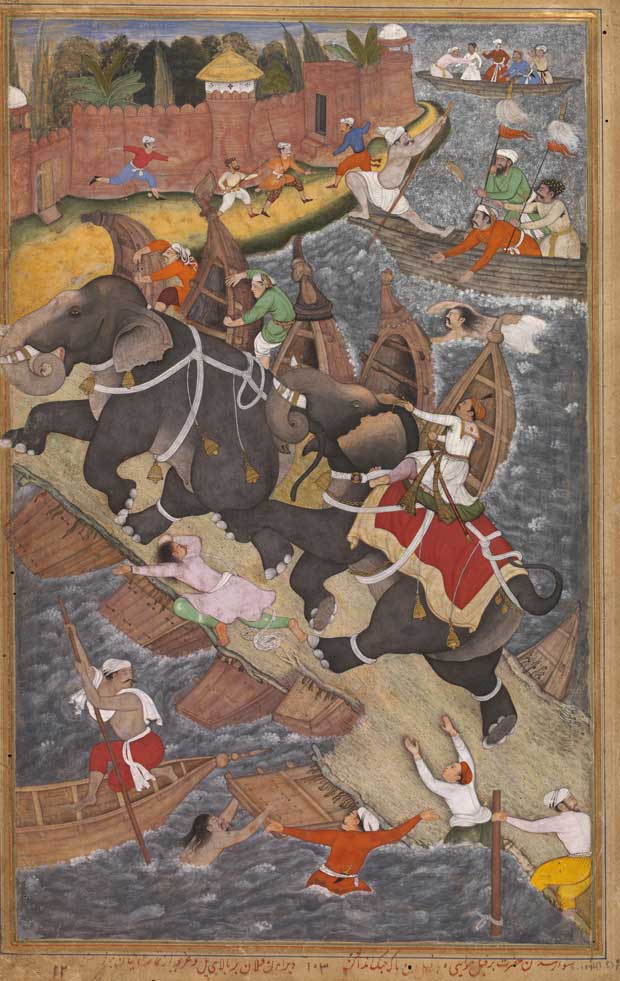 Composition by Basawan painting by Chatra - Akbarʼs adventure with the elephant Hawaʼi / Folio from the Akbarnama (Book of Akbar), c. 1590-1595, Ink, opaque watercolour and gold on paper, 37,5 x 23,8 cm, Victoria and Albert Museum, London
Composition by Basawan painting by Chatra - Akbarʼs adventure with the elephant Hawaʼi / Folio from the Akbarnama (Book of Akbar), c. 1590-1595, Ink, opaque watercolour and gold on paper, 37,5 x 23,8 cm, Victoria and Albert Museum, London
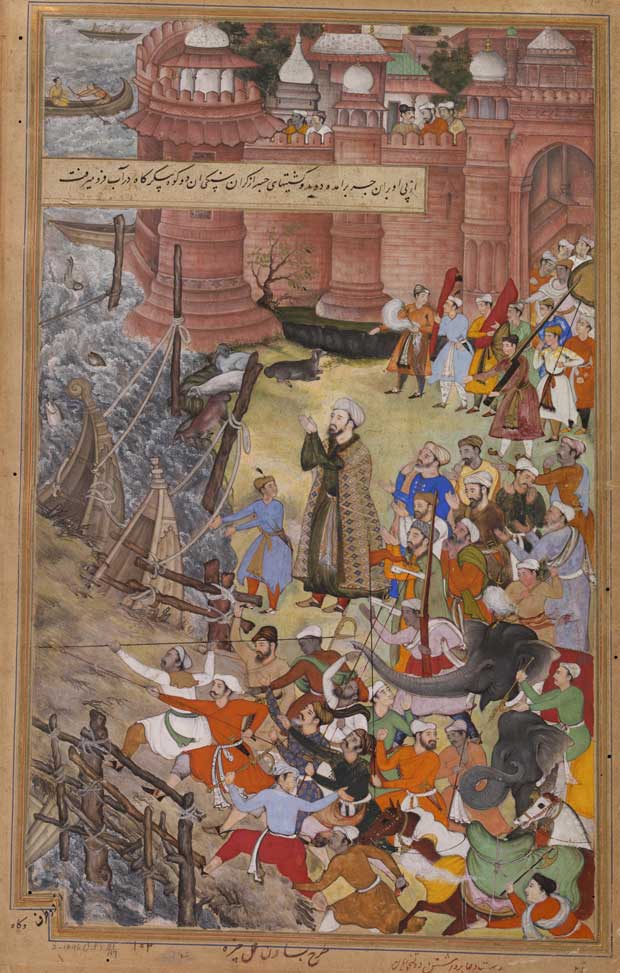 Unattributed, but composition probably by Basawan Akbarʼs adventure with the elephant Hawaʼi, Folio from the Akbarnama (Book of Akbar), c. 1590-1595, Ink, opaque watercolour and gold on paper, 37,5 x 23,4 cm / Victoria and Albert Museum, London
Unattributed, but composition probably by Basawan Akbarʼs adventure with the elephant Hawaʼi, Folio from the Akbarnama (Book of Akbar), c. 1590-1595, Ink, opaque watercolour and gold on paper, 37,5 x 23,4 cm / Victoria and Albert Museum, London
Jalaluddin Muhammad Akbar reigned from 1556 to 1605. He was the most important Mughal Emperor and became Akbar – meaning ʻThe Greatʼ – as a result of his military commitment and numerous conquests and also because of his administrative reforms and ability to make different religions live together and to spread culture, art and beauty throughout his realm.
The exhibition has a vast collection of works of art that aim to describe the classical India that circulates in the Western social imaginary - formed of Mughal Emperors, Rajas and Maharajahs - and was a destination for explorers, merchants and conquerors who arrived in that mysterious, rich and fascinating land from all over the world. Of Muslim lineage, the Mughal were founded by Babur, the first to have conquered India and descendant of Genghis Khan (1162?-1277) and Timur (1369-1450), who lived from 1483 to 1530 and reigned from 1526 until his death. When Babur died his sons, Kamran Mirza and Humayun, Akbarʼs father, divided the territories of his realm, though a civil war soon broke out and drove Humayun into exile in Persia. During his peregrinations, Akbar was born, in 1542, in the Rajput Fortress of Umerkot (now Pakistan) and had to be fostered by an uncle in Afghanistan. Since the future Emperor grew up hunting and fighting amidst soldiers he was not taught to read or write: though he remained illiterate throughout life, he still developed a taste for art, music, literature and architecture.
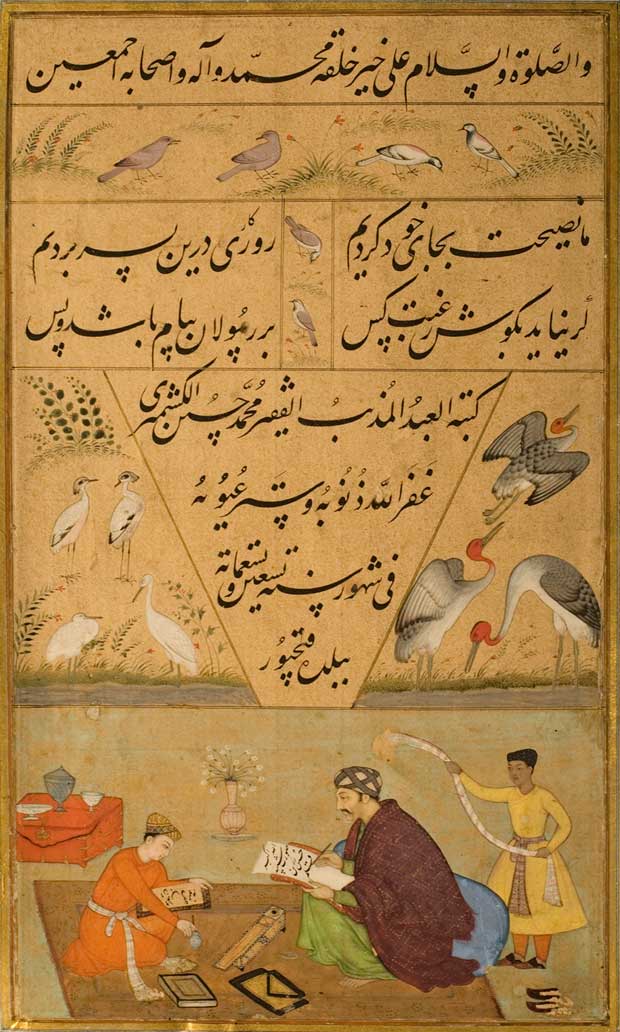 Saʻdi, Gulistan (The Rose Garden) / 26 January 1582–24 January 1583, Ink, opaque watercolour and gold on paper, 31.8 x 20.3 cm / Royal Asiatic Society of Great Britain and Ireland, London
Saʻdi, Gulistan (The Rose Garden) / 26 January 1582–24 January 1583, Ink, opaque watercolour and gold on paper, 31.8 x 20.3 cm / Royal Asiatic Society of Great Britain and Ireland, London
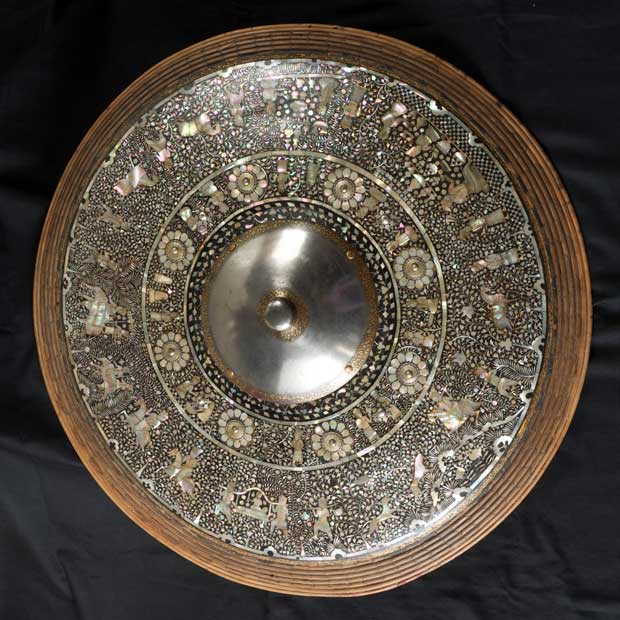 Shield, West India (Gujarat?) / c. 1575, wicker, leather, velvet, steel with intarsia in gold and mother-of-pearl on black bituminous paste, diameter 59.4 cm / Museo Nazionale del Bargello, Florence
Shield, West India (Gujarat?) / c. 1575, wicker, leather, velvet, steel with intarsia in gold and mother-of-pearl on black bituminous paste, diameter 59.4 cm / Museo Nazionale del Bargello, Florence
Divided into five sections in order to render the best interpretation of the Emperorʼs works and historical-social environment, the exhibition evokes the fabulous splendour of the Mughal court through watercolours, paintings, book illustrations, extremely rare fragments of fabrics, carpets, objects and weapons studded with gems and introduces visitors to Akbarʼs internationalism and influence on Europe in the seventeenth, eighteenth and nineteenth centuries.
The first section describes several times in the private and public life of the Emperor through works such as Akbar receiving gifts and The birth of Salim in 1569. Akbarʼs eldest son, Salim, was born from his marriage with Hira Kunwari and subsequently became Emperor Jahangir, Conqueror of the World. He was born in Fatehpur Sikri the new capital built by Akbar in thanks of the unexpected son. The bright colours of the clothes and the rituality of the usages and customs of the environment are splendidly conveyed in these works, where the architecture of the new realm forms the background of the precious tempera and watercolours on paper enriched with gold.
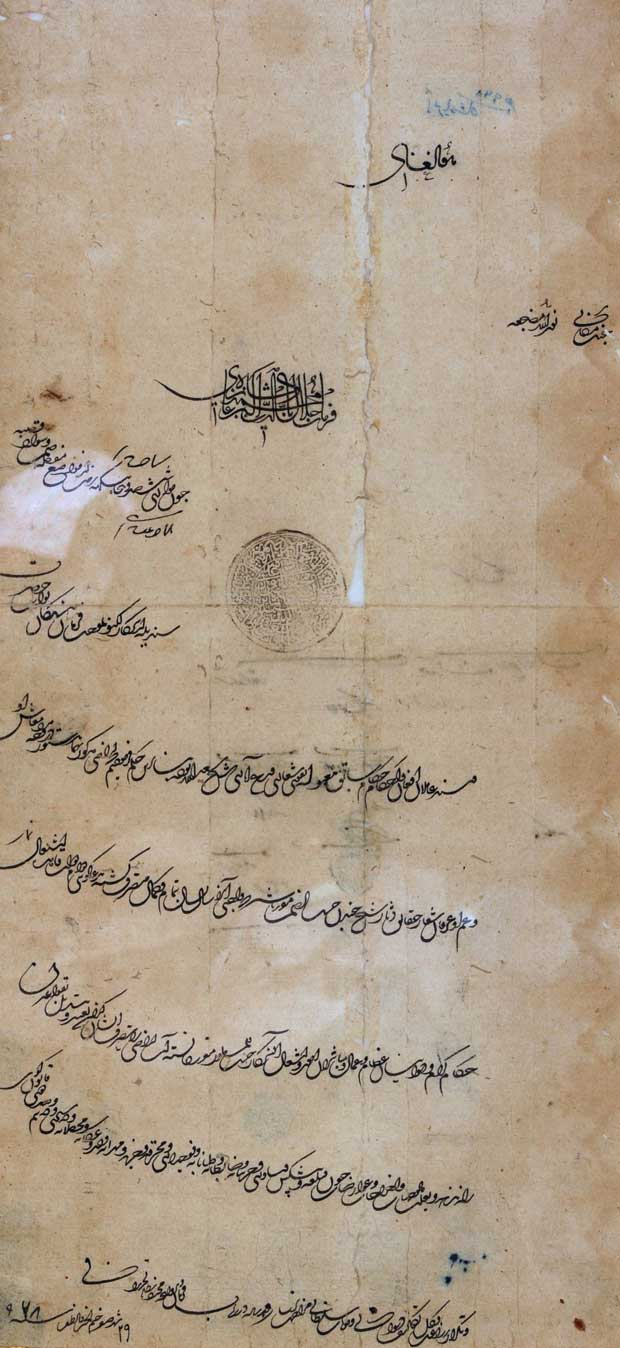 Farman of Jalaluddin Muhammad Akbar, 1561 (968 AH), Ink on paper, 58,00 x 28,50 cm, National Museum, New Delhi
Farman of Jalaluddin Muhammad Akbar, 1561 (968 AH), Ink on paper, 58,00 x 28,50 cm, National Museum, New Delhi
The second section illustrates, through period depictions, the construction of the cities and progress in architecture and town planning. In paintings such as Akbar Inspecting the Construction of Fatehpur men and animals (including the large Indian elephants) are to be seen intent in building walls and palaces in Akbarʼs new style. Other pictures describing the previous Emperorsʼ commitment to public works, as seen in Babur Supervising the Construction of a Reservoir on the Spring of Khwajah Sih Yaran, near Kabul, from the Baburnama (Biography of Babur), are also on show.
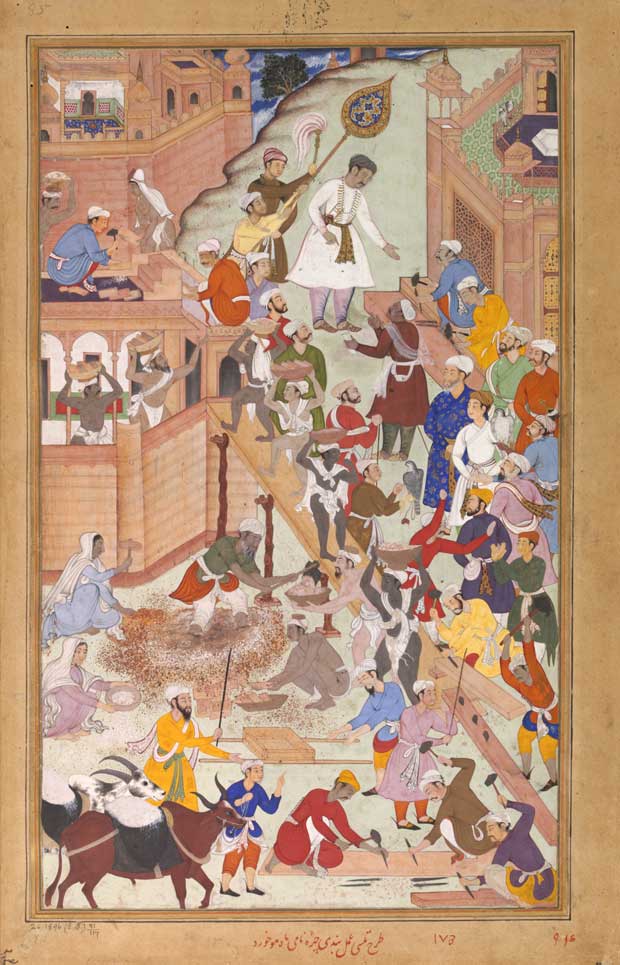 Composition by Tulsi, painting by Bandi, faces by Madhav Khord Akbar inspecting the construction of Fathpur / Folio from the Akbarnama (Book of Akbar), c. 1590-95, Ink, opaque water color and gold on paper, 37,6 x 24,3 cm, / Victoria and Albert Museum, London
Composition by Tulsi, painting by Bandi, faces by Madhav Khord Akbar inspecting the construction of Fathpur / Folio from the Akbarnama (Book of Akbar), c. 1590-95, Ink, opaque water color and gold on paper, 37,6 x 24,3 cm, / Victoria and Albert Museum, London
This section exhibits handmade items for domestic use and exportation to the West, such as antique carpets and wedding blankets, jewel cases and refined chests inlaid with ivory, brass and mother of pearl which document the wealth and sophistication of Akbarʼs court. There are also works elegantly decorated with animals and Phytomorphic motifs, as in the Carpet with Bird Couples in a Landscape and the Fragment of a Carpet. Manuscripts, sculptures, Indo-Portuguese fabrics and decorative accessories from some of the chief Indian, European, North America and Arabian collections are also displayed.
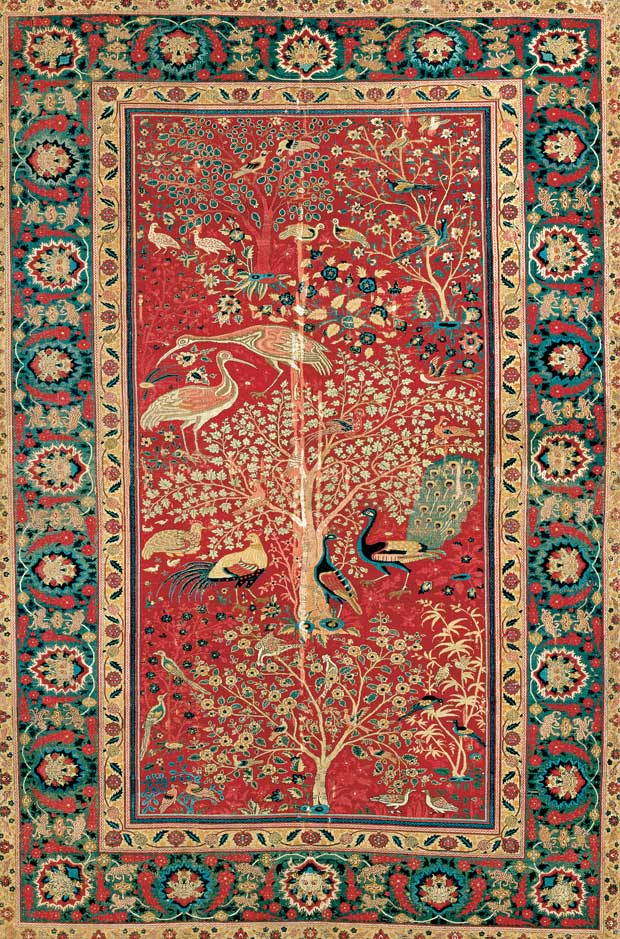 Carpet with birds couples in a landscape, Lahore, c. 1600, Warp and weft in cotton, wool, asymmetric knot, 233 x 158 cm / MAK, Museum für angewandte Kunst, Vienna, From Handelsmuseum
Carpet with birds couples in a landscape, Lahore, c. 1600, Warp and weft in cotton, wool, asymmetric knot, 233 x 158 cm / MAK, Museum für angewandte Kunst, Vienna, From Handelsmuseum
The fourth section contains works such as Babur Hunting Rhinoceros near Bigram (Peshawar) dated the 10th December 1526 and Akbarʼs Adventures with the Elephant Hawaʼi which depict War, battles and hunting and the practice of using mighty elephants in great hunting expeditions, amongst which Hawaʼi, often portrayed mounted by Akbar, that according to the legend was one of the strongest and most difficult elephants to handle, yet the great Emperor rode him with ease. Battle and parade weapons, often studded with gems of a heavy carat weight like the great hunting expeditions, or the Single edged curved sword, in damascened steel, wood and velvet, are also exhibited.
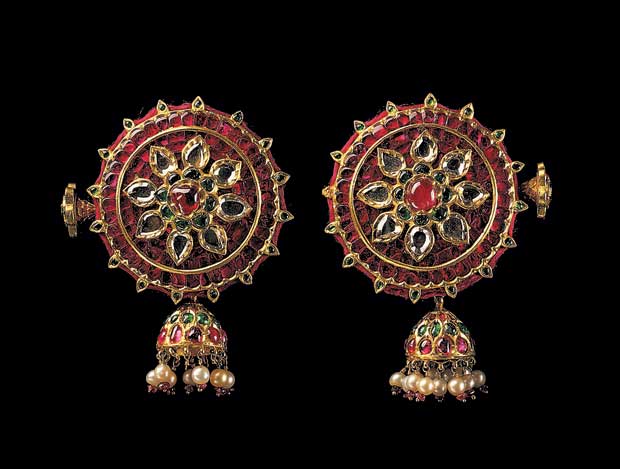 Pair of Earplugs, Probably Mughal dominions, Probably earlier 17th century, Fabricated from gold, worked in kundan, technique and set with rubies, diamonds and emeralds; and strong with pearls, 8,2 x 6,3 cm / The al-Sabah Collection, Kuwait
Pair of Earplugs, Probably Mughal dominions, Probably earlier 17th century, Fabricated from gold, worked in kundan, technique and set with rubies, diamonds and emeralds; and strong with pearls, 8,2 x 6,3 cm / The al-Sabah Collection, Kuwait
The Exhibition entitled Akbar. The Great Emperor of India has been promoted by the Fondazione Roma and organised by Fondazione Roma-Arte-Musei with the Arthemesia Group and shall be held in the halls of the Museo Fondazione Roma, Palazzo Sciarra, from the 23rd October 2012 to the 3rd February 2013. The event is supported by the Italian Ministry for Cultural Heritage and Activities, and has been accomplished through the involvement of the Italian Embassy in New Delhi and Indian Embassy in Rome.
Comments
Add a comment